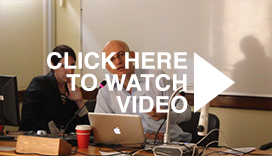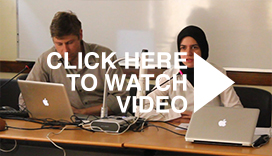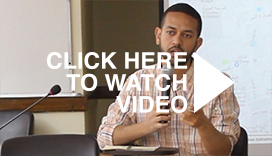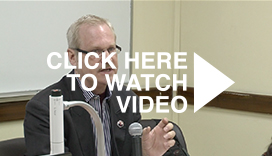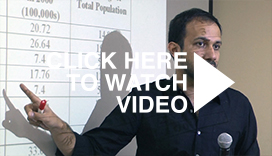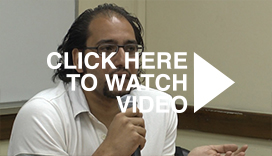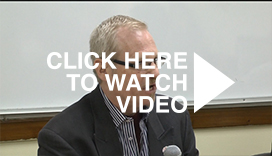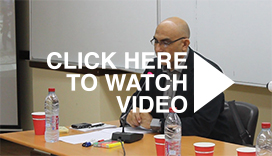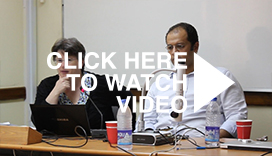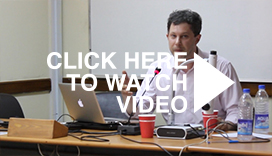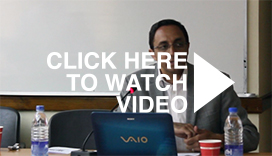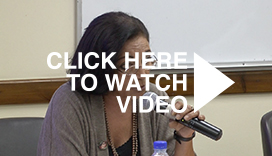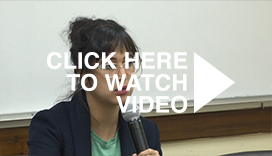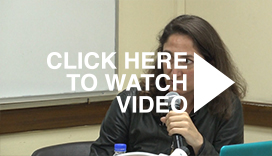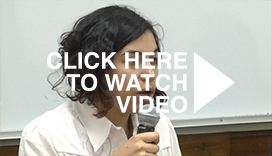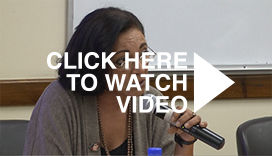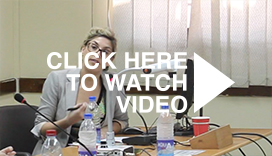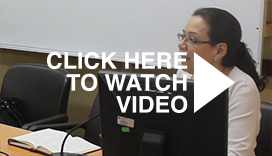
Video of presentation by Omar Nagati and Beth Stryker, CLUSTER
Video of presentation by Gregers Tang Thomsen and Selva Gürdoğan, Superpool
During the first presentation, Cairo Lab for Urban Studies, Training and Environmental Research (CLUSTER), offered case studies from their ongoing research project, Archiving the City in Flux. This project aims at capturing the fleeting moment of urban fluidity, whereby individuals and communities are taking advantage of the political vacuum and the increasing vulnerability of the state, with its relative absence of law enforcement agencies, to maximize gains over public spaces and city infrastructure. Omar Nagati and Beth Stryker, co-founders of CLUSTER, shared their research methodology and sample documentation and analysis of the changing urban landscape in Cairo since January 2011. Their examples included street vendors in Downtown Cairo whose significance, according to Nagati and Stryker, transcends the immediate context of sidewalks to evoke larger questions concerning the battle over public space amidst competing and conflicting frames of reference. “Whose public? Who decides what types of uses take place there? And what are the norms governing these practices?” were some of the questions raised by CLUSTER.
On a larger scale, Nagati and Stryker presented the case study of a highway exit, or off-ramp from the ring road, which was constructed entirely by the local community of al-Mu‘tamidiya to provide access to major city infrastructure, from which they had been hitherto excluded. CLUSTER argued that this act of defiance, which clearly demonstrates the local community’s organizational capacity to mobilize resources, local knowledge and technical knowhow, is itself a statement whereby the community redefined their urban citizenship with respect to the city and public space. Methodologically, CLUSTER’s tools ranged from photo documentation, time-lapse photography, GPS and other geo-referencing techniques to map the wide range of informal practices. Finally, CLUSTER presented their newly-launched project and website: Cairo Urban Initiatives Platform (CUIP: http://www.cuipcairo.org), a communitydriven database, which aims at mapping civil society organizations working with art, architecture, urban advocacy, discourse and media, academia and research, and those whose interest revolves around the city, the urban environment and public space in Cairo. CUIP includes an interactive map, a directory and a shared events calendar.
Selva Gürdoğan and Gregers Tang Thomsen from Superpool presented their project, Mapping Istanbul, which aims in part at making visible select informal networks in Istanbul. The project was originally commissioned by Garanti Gallery to map current data on population, economic activity, education, land use, transportation, earthquakes, buildings, housing, health, social infrastructure, consumption, and energy. This was published in a book of the same title in 2009. Superpool made the point that unlike CLUSTER’s research undertaken in Cairo post January 2011, Mapping Istanbul was not developed “during a time of stress” and that they had more time and leisure for their investigation. They also noted that while the project’s defined purpose was to offer accessible visualizations of data, the book was produced in English and in a limited edition.
Some of Superpool’s mapping projects include the Dolmuş Minibus Map. Other maps link geographical distribution of educational, health and recreational services, for example, to larger social and political questions, such as accessibility, connectivity, uneven distribution of resources.
Superpool presented three linked exhibits. Becoming Istanbul, The Making of Beyoglu, and 90, were extensions of the Mapping Istanbul project, inviting participation from a broader public. Becoming Istanbul continues to make available an interactive database, including artists’ videos, documentaries, and architectural projects, related to issues often underreported in urban discourse. Making Of Beyoglu consisted of public workshops related to urban planning projects in the city center. 90 saw 90 days of accessible events that engaged contemporary questions related to Istanbul.
The last example Superpool presented was their Women’s Guide to Diyarbakır project. Diyarbakır, a city in southeast Turkey, became home in the 1990s to hundreds of thousands of internally displaced people (IDPs). They faced what Superpool refers to as a “traumatic urbanization experience” due to issues of inadequate housing, lack of access to services, chronic poverty, domestic violence and state oppression. By the early 2000s these factors had led to a high suicide rate among young women. The local municipality along with local activists, facing difficulties reaching out to women, devised a decoy in laundromats. The Women’s Guide to Diyarbakır designed by Superpool mapped the location and services of relevant NGOs. Conceived as a printed map to be distributed by the municipality, the project faced a shortage of funding. The map was later commissioned by and presented at the International Architecture Biennale Rotterdam.
Discussion:
Mohamed Elshahed, moderator of the discussion, questioned whether mapping, as an abstraction of reality into “signals and signs,” risks rendering itself irrelevant to its intended audience. Revolving around this issue of target audience the ensuing discussion questioned whom and how maps serve: as a body of knowledge for researchers and academics? As implementation tools for planners and decision-makers? Or as modes of empowerment for local communities whose environment itself is being mapped?
Another related set of questions addressed the accessibility of visualization tools. Some skeptics voiced their concerns whether websites are an appropriate means of dissemination for the wider public in Cairo, questioning the possibility of participation and input by broader societal groups. Ease of reproduction and dissemination were also raised as issues, with respect to how accessible different media for map representations may be.
The issue of mapping as a potentially objectifying process raised a number of debates: to what extent may the rendering visible of informal practices contribute to further empowering communities versus making them more vulnerable to hegemonic policies and formalization attempts? In what ways can “mapping from below,” such as projects undertaken in Cairo and elsewhere using OpenStreetMap open source software, enable communities to map their environment on their own terms?
Finally, the discussion delved into the pragmatic question of what would be the use of mapping informality for planners and policymakers. Can we as architects and planners distill alternative norms and standards from the body of documented informal practices, in a manner different to those taught in universities and applied by planning institutions?
In summary, the session helped shed light on two critical terms and modes of social practice: “mapping” and “informality.” Both could be critical tools to interrogate the entrenched power relations and top-down planning paradigms of our cities and organizational structures of our spaces. Further, they may be used as empowering strategies or subversive tactics, amid the fast changing political and urban landscapes of our cities and societies.
Omar Nagati
Omar Nagati is a Ph.D. candidate and practicing architect/urban planner living in Cairo. A graduate of Cairo University, he studied and taught at the University of British Columbia and…
Beth Stryker
Beth Stryker works between NYC and the Middle East and has recently curated exhibitions and programs for the Beirut Art Center, the AIA/Center for Architecture in NYC (where she…
Video of presentation by Gregers Tang Thomsen and Selva Gürdoğan, Superpool
SUPERPOOL
SUPERPOOL: Selva Gürdoğan, Architect (born 1979, Turkey. 2003 graduate from Sci-Arc, USA) and Gregers Tang Thomsen, Architect (born 1974, Denmark. 2003 graduate from Aarhus School of Architecture, Denmark) founded Superpool in Istanbul in 2006…
Video of Q&A led by Mohamed Elshahed, Cairobserver
Mohamed Elshahed
Mohamed Elshahed is a doctoral candidate in the Middle East and Islamic Studies Department at New York University. He lives in Cairo, where he is conducting dissertation research on architecture…
Video of Introduction by Joseph Schechla, Housing and Land Rights Network, Cairo
Video of presentation by Gautam Bhan, Indian Institute for Human Settlements, Delhi
Video of presentation by Yahia Shawkat, Shadow Ministry of Housing, Cairo
Video of Q&A led by Joseph Schechla, Housing and Land Rights Network, Cairo
Guatam Bhan, began his presentation by taking issue with the International Covenant on Civil and Political Rights, problematizing the notion of citizenship rights on global, national and urban levels. Citing James Holston’s definition of “insurgent citizenship,” Bhan referred to his research in India, observing that the elite often define themselves as Delhi citizens while the poor regard themselves as citizens of India. He emphasized the distinction between marginalized communities at the city’s peripheries, such as those in Bulaq and ‘Izbat al-Hajjanah in Cairo, who make claims to urban citizenship as a “turn away [rather than] turning to the state.” He compared this to the example of China, where one is born either a rural or urban citizen, which defines the benefits one is entitled to by the state, such as health and education.
Bhan elaborated on the development of informal settlements through the classic patronage of the state or clientelism, as communities time their encroachment on land with elections and voting banks. They invade, occupy, build, introduce services, and wait for elections. “Our cities are not planned,” he declared. In contrast to what is taught in planning schools, where plans precede construction, “the way we settle is, first you occupy, then incrementally you build a little bit of money, another wall, you get one service at a time, so services come incrementally, at the very end do you think about reentering the plan.”
Referring back to his research in India, Bhan made the distinction between two phases marking eviction campaigns under dictatorship and democracy. The first big cycle of evictions took place between 1973 and 1981, when martial and emergency laws were declared; and then again between 2002 and 2010, after the state allowed the poor to build illegally. But while the first cycle of evictions happened during the time when constitutional safeguards were suspended, the second took place under a functioning democracy, he claimed.
Bhan posed the question of how in a functional democracy you manage to get evictions of this scale and not suffer the consequences, and proposed to address this paradox by framing informality in three ways: the first being an “informality in use,” which means using land in ways unintended or for which it is not planned/zoned. The second is informality in transaction, referring to whether or not one has a written form, paying by check every month to buy a house in al-Hajjana, for example. The third is informality as illegality, defining the title to one’s house and whether the state recognizes it as a legal property right, and thus the ability get a bank loan on it, or a mortgage.
In conclusion, Bhan suggested framing informality not as a question of illegality but of legitimacy, arguing that “our concern should be about legitimate housing as opposed to legal or illegal, formal or informal.” He concluded his presentation by proposing three questions or provocations: The first concerns the threat of eviction: “Do you have the right to remain? Are you literally unable to stay in the place where you are? The second questions the correlation between informality and the provision of services and infrastructure.” In India, he explained, service providers since 2006 have been told “It is not your job to see if something is legal or illegal, you’re a water company, put water connections.” The last question he posed was “How do you exist as a citizen?” He argued that very often, spatial illegality is connected to the inability to exist on paper. People without a formal address, or who don’t receive bills, or don’t have a meter, are asked the ironic question of “Can you prove who you are? And can you prove where you live?” Bhan then elaborated on types of informal settlements in the Indian context, arguing that many of these settlements survived outside the law. He concluded by raising questions as to how they survived and became legitimate, calling for alternative ways to think about actual negotiations rather than legal categories.
The second presenter, Yahia Shawkat, began with a provocative slide of an “Eviction Decree” document, or Qarar Istila’, a term associated in Arabic with theft. He contemplated why the Egyptian government would use criminal terminology in their official certificates for land takeover.
Shawkat then embarked on a criticism of the centralized planning that has been a ruling paradigm in Cairo for decades. He demonstrated that decisions to allocate land for housing are complicated by the multiple ministries at play, at the top of which are the Ministries of Defense, Antiquities, and Petroleum. The consent of these three ministries are a precondition for any land to be allocated for development outside the Nile Valley, which itself represents only six percent of the total area in Egypt. The Ministry of Housing, he argued, sits at the bottom of this hierarchy. Shawkat pointed out that top-down “high modernist” planning is manifest in thinking in two dimensions, getting out a marker and saying “this is where certain things are going to happen.” It fails to consider carefully what is going to be developed in that place, and to engage the participation of communities which live in a chosen location, or might be relocated under a given plan. Further, Shawkat criticized the New Cities program and its land allocation strategy, whereby market-driven speculations have led to unfair competition and legalized exclusion. He presented a detailed analysis of land prices, densities and land allocation mechanisms, which exacerbate the inequality of land distribution in housing development projects.
Shawkat then presented an overview of the Cairo 2050 master plan, arguing it is a “marriage between top-down planning and this very sort of neoliberal look at Cairo […] investing every last inch out of it,” whereby “all the poor people and the vulnerable” are being pushed out of Cairo in order to turn it into a “‘world class’ city.” This plan is only possible, he argued, because of law number 10 for 1990, called qanun naz’ al-milkiyah lil-manfa’ah al-‘amah, or the revoking of property for public benefit. Shawkat listed the eight different uses the law provides for expropriation due to imminent domain, including clear use, such as water, infrastructure, and transportation projects. But the law also includes very vague designations, such as the term “for planning and upgrading” and those “considered for public benefit,” which Shawkat cautioned could lead to potential abuse and the eviction of marginal communities.
In the last segment of his presentation, Shawkat cited a number of projects related to Cairo 2050 that would result in the expropriation of property and potential evictions. He referred to the 2005 clearing of an area along the Nile Corniche, Hikr Abu Duma, after it was designated an “unsafe area” to make room for high-end towers. Shawkat estimated that 350-400 families were evicted then.
Shawkat pointed out the legal loopholes that impacted the extended district of Ramlat Bulaq with respect to variable compensation to a community made up of renters, squatters, and people with very clear tenure. “Are they all going to be compensated equally? Is the government going to compensate the landlord and the tenants, both or not?” he exclaimed. In the Maspero Triangle, Shawkat pointed out the buildings that will survive future demolition, such as the TV building, the Ministry of Foreign Affairs and the Nile Hilton. The rest of the area is facing targeted eviction, he suggested, where the governorate has been using various tactics to depopulate the area over the years. Some have not been allowed to get water or electricity for the last few years. There was also a governorate decree for buildings not to be rebuilt if they fall, and banning the restoration of buildings in poor condition, which would lead to their dereliction and eventual collapse.
The last example Shawkat presented was ‘Izbat Khayrallah, where a six-lane highway cuts through this dense informal housing area. He pointed out additional cases where the construction of traffic corridors, such as Saft al-Laban and the prospective Rod al-Frag dissect existing communities, raising questions of public benefit, and the role of the private sector within the “public-private partnership” development framework.
As moderator, Schechla offered an overview of international law to frame the three essential concepts developed by the panelists in their case-based presentations: tenure security, citizenship and eviction. He pointed out that international treaty law guarantees the human right to adequate housing. In summary Schechla noted that individuals and communities subject to forced evictions without state procedural safeguards outlined by international law, “are entitled to reparations, legally defined to include restitution (return, resettlement and rehabilitation), compensation for losses and values that cannot be restored, guarantees of non-repetition, and satisfaction at justice served.”
Video of presentation by Gautam Bhan, Indian Institute for Human Settlements, Delhi
Gautam Bhan
Gautam Bhan is a Senior Consultant for Curriculum Development and Policy and Advisory Services at the Indian Institute for Human Settlements. Gautam’s research and writing has focused on the politics…
Video of presentation by Yahia Shawkat, Shadow Ministry of Housing, Cairo
Yahia Shawkat
Yahia Shawkat is a built environment researcher and critiques built environment policy on his blog, Shadow Ministry of Housing. The Right to Housing Initiative, which identifies a greater right to housing…
Video of Q&A led by Joseph Schechla, Housing and Land Rights Network, Cairo
Joseph Schechla
Joseph Schechla has focused much of his research and field experience on popular movements and legal defense of economic, social and cultural rights within the UN Human Rights System. His articles…
Video of presentation by Mokena Makeka, Makeka Design Lab, Cape Town
Video of presentation by Mohamad Abotera and Ahmed Zaazaa, MADD Platform
This working session brought together, in discussant Amr Abdel Kawi’s words, “vastly different projects, which represent opposing approaches, but share the common goal of reaching a collective vision to effect change in the city.” The objective of the session was to present ways in which design innovation can inform and address the issue of urban development.
Mokena Makeka began the session with a presentation titled Identity, Politics and Aesthetics in Architectural Practices. Makeka originally intended to present a discussion of public spaces, but was inspired by the presentation of the Cairo 2050 vision in day one of the conference, and instead discussed his own work on the Cape Town 2030 vision. He framed the discussion of a project for a city transport and activity hub, the Cape Town Station, in the context of this vision. The first factor he discussed was the effect of climate change and resource management on the city’s future. The client in the Cape Town Station project was Intersite, the property arm of the Passenger Rail Agency of South Africa, the largest landowner in the city. Makeka made the case that the re-thinking of the future of the city was driven not the city itself, but by its largest landowner: the railway authority.
The main issue addressed by the project was mobility, with attention to how mobility supports and integrates communities. In addition to mobility and efficiency, factors in the design of this project included questions of justice and governance. Ultimately the station project brief was developed not only by the client, but with public participation as well. The conclusion was that the station must act as a mobility and activity hub for the city, in addition to acting as an inspirational vision for a world city.
One of the important goals of the station soon became one of equity – providing an additional transportation grid, overlaid with a public space grid, giving access to those previously excluded. This helped bridge the historical apartheid divide between classes and socio-economic groups within the city. This was a clear departure from previous practices where railway lines were used to delineate and emphasize these divides, rather than erase and integrate their inhabitants. The location of the station itself became an instrument to address various developmental needs, and to help achieve this integration and equity.
Historical context also plays a role in the development of the Cape Town 2030 scheme presented by Makeka. In comparison to Cairo 2050, the Cape Town scheme is carved around historical footprints, integrating open public space with historical sites, as opposed to cutting across historical layers as if they do not exist in the collective and physical memory of the city. Another important role this project played was in the navigation of socio-political forces in balance with the betterment of the city, particularly between the different parties – politicians, railway authorities and the local government of the city of Cape Town.
Madd Platform presented their similarly positioned work in al-Kum al-Ahmar and Mit ‘Uqba, implemented in a different mode, with incremental models utilized as an approach to urban development. The premise for their work began with the inherent disparity seen in much of Cairo between what the designer conceives to be a functional system, and communities’ needs-adapted patterns of use. This is commonly referred to as “informality,” and is seen by designers as conditions to be tamed, but Madd Platform propose instead to work with informality. Their proposed adaptations apply to all levels – from the architectural detail to the city scale.
To better address and understand these phenomena, Madd began by identifying the various constituents and user groups: including citizens, the government, business owners and those with economic interests, civic society groups, and funding agencies. In Cairo, as in many other cities, decision-making processes are inherently inequitable, driven by access to power – be it through politics or financial interests. Such top-down approaches and processes however are not the only systems that exist, and other parallel user-driven processes currently flourish in the context of Cairo’s informal urbanism.
It is this parallel, bottom-up process that Madd presented as an alternative mode of practice. In this process the designer begins with the user to identify their needs, and these user-driven designs are taken to the local authorities and policy makers for approval. Funding agencies are then addressed with a final design strategy for submission to the government for approval.
Madd delineated three levels of decision-making processes: that of the state, that of the citizens, and that of local authorities (mahaleyat), each operating with their own scale and scope. They posed the designer’s role as that of navigator: integrating and coordinating these processes in a constructive manner. Examples of the discord that manifests without such navigation can be found in Cairo’s Ring Road: designed to belt off the city and prevent urban expansion, it instead became, through citizen-driven initiatives, a catalyst for urban growth. Designer interventions in such cases, Madd proposed, can help reconcile the intent and interests of both parties.
Madd was established after the January 25th Revolution to address this navigational role on three levels: through policies, research and field work. They evolved micro-models that are adaptable, community responsive, and multi-sectoral and put their conception of the new role of the designer into practice in their projects in al-Kum al-Ahmar and Mit ‘Uqba.
Although they presented two seemingly disparate projects, both Mokena Makeka and Madd Platform have at their core a similar intent – to achieve comprehensive community aspirations by mediating between policymakers and citizens on the ground.
The session entitled Design Innovation and Urban Development brought together two vastly different projects, which represent opposing approaches, but share the common goal of reaching a collective vision to effect change in the city. The first was presented by Mokena Makeka of South Africa’s Makeka Design Lab, who related his firm’s design proposal for the regeneration of an inner city plot of Cape Town owned by the nation’s railway company; while the second experience was presented by Mohamed Abotera and Ahmed Zaazaa of MADD Platform, a collective of multidisciplinary professionals, on a project to upgrade the main street of the informal settlement of Kom al-Ahmar in Cairo. The first presentation outlined a top-down approach to urban regeneration. This project presented a land-owning client, with economic interests, focused on the need to generate additional revenue as a result of the planned removal of government subsidies. The second presentation outlined a bottom-up approach where the client was basically the local neighborhood community who were struggling with ownership issues and interested in better living conditions. The challenge for both professionals was how to reach a collective vision for the community and to reflect that in a better urban context. In Makeka’s experience there was a clear attempt to include in that vision the perspective and interests of a diverse community in what was traditionally a segregated city. However, the extent of such inclusion is limited by maintaining the client’s overall interests. The MADD Platform team, on the other hand, attempted to downgrade the professional’s role to one of interpreter of the community’s needs. The underlying assumption is that the informal urban generation process in such communities continues in any case, and here the professional intervention is simply to try to steer it in a better direction. The key question raised by the opposing perspectives of both presentations focuses on the social role of the designer or planner and his or her relationship with the clients. One of the more interesting remarks emerging from the ensuing discussions proposed a middle level to connect the disparate levels of top-down and bottom-up. This middle level might be represented by what could be viewed as a new form of professional institution, offering support to both the public and government so as to balance priorities from a neutral stance. Irrespective of whether such neutrality is possible, it is clear that a new approach needs to be explored.
Presentation by Mokena Makeka, Makeka Design Lab, Cape Town
Mokena Makeka
Mokena Makeka is principal and founder of Makeka Design Lab. His highlight was being selected among 100 architects globally by Herzog and de Meuron to be a part of the…
Presentation by Mohamad Abotera and Ahmed Zaazaa, MADD Platform
Mohamed Abotera
Mohamad Abotera was trained as an architect in Egypt and obtained his MA degree from the University of Westminster in Architecture, Globalization…
Ahmed Zaazaa
Ahmed Zaazaa is an architect, urban designer and researcher, and he focused on informal territorial claims in public space and housing for his master’s thesis. He is particularly…
Q&A led by Amr Abdelkawi, Department of Construction and Architectural Engineering, School of Sciences and Engineering, AUC
Amr Abdelkawi
Amr Abdelkawi has completed his education in architecture in the United States and practiced architectural design in Egypt for over twenty years through his architectural practice Praxis. He eventually diversified…
Video of presentation by Kareem Ibrahim and Diane Singerman, Tadamun
Summary of Working Session 4 by Discussant Khaled Abdel Halim
Beginning with a critique of the infamous Cairo 2050 master plan, Diane Singerman and Kareem Ibrahim addressed the necessity for urbanists to balance future planning, and regional and global concerns, with a respect for the urgent and immediate on site needs of communities. They went on to present three case studies to illustrate the research they are undertaking under the umbrella of Tadamun: Cairo Urban Solidarity Initiative, which Singerman and Ibrahim founded to promote “realistic alternatives and solutions for existing urban problems.”[i] They presented Mit ‘Uqba as an example of good governance in action, exhibiting transparency and the participation of the community; Nahia Urban Center as a model of cooperative partnership between local government and civil society for solid waste management; and ‘Izbat Khayrallah for their constructive cooperation with the government to resist eviction, secure tenure and ultimately receive basic infrastructure.
Tadamun’s presentation highlighted in-situ development in Cairo as an alternative to urban expansion to new cities, which has led to a diversion of resources from communities in need. They further advocated for the reversal of practices of previous decades that have led to the disconnection of communities from their urban environments. They outlined issues of social inclusion as important characteristics of their work with communities, as well as the right to information as articulated in their Know Your City initiative. Finally Tadamun stressed the need for the democratization of local planning, and for the inclusion of urban issues as part of local governments’ election agendas.
In a vastly different context, Damon Rich’s presentation similarly highlighted the advantages of community participation. Bridging the community-state gap, given his former role as the founder of CUP, and his current role as the first Chief Urban Designer for the City of Newark, New Jersey, Rich was able to provide unique insight into the participatory process. He shed light on the limitations of formal avenues for such participation, in this case public hearings on urban planning. Like Tadamun, Rich advocated for more immediate, on-the ground and proximal engagement of communities in the planning process.
Rich illustrated these points through examples of the work of CUP, a nonprofit that uses design and art to improve civic engagement. The first involved youth education, using role-play to educate and engage New York City high school students about solid waste management issues in their communities. The second highlighted CUP’s Making Policy Public campaign, in particular their creation of visual materials in collaboration with a union of street vendors, to provide an accessible tool for communicating street vendors’ rights across cultural and language divides, as well as to advocate changes to current legislation. This initiative capitalized on existing networks and distributive capacities among street vendors, effectively engaging their participation. Finally Rich highlighted CUP’s production of a toolkit designed for use in workshops by organizations trying to mobilize people around issues of affordable housing.
Throughout the working session, the urgent and often highly effective and constructive role of community participation was emphasized across urban examples from Egypt and North America. These experiences highlighted the increasingly important role of the architect and urban planner as a mediator and negotiator of the often complex relationships between communities and state. They highlighted the multi-disciplinary role of these professionals as negotiators, activists, advocates and facilitators of crucial partnerships, towards the ultimate goal of more sustainable and inclusive urban environments that address the realistic, immediate, as well as long term needs of their communities.
[i] Tadamun: Cairo Urban Solidarity Initiative, date unknown. About Tadamun. [online] Available at: <http://tadamun.info/demo/about> [Accessed 04/10/2013]
One of the main sources for Learning from Cairo after the January Revolution is community activism. The TADAMUN project (Cairo Urban Solidarity Initiative) demonstrates the importance of documenting urban interventions on the ground, providing examples of communities involved in processes affecting their built environment. TADAMUN further emphasizes the current need to support people’s initiatives, rather than planning in the long term, or focusing only on policy and institutional reforms. We must pay attention to the events of Cairo 2013, prior to planning for Cairo 2050.
The main features of the TADAMUN initiative presented at the Learning from Cairo conference were:
- Promoting development in-situ by supporting community initiatives rather than directing public resources and interests to new cities.
- Undoing neoliberalism as a governing force of urban development and unmaking fortress architecture, which increases urban segregation.
- Building a city for all, in terms of social and urban inclusion.
- Supporting citizens’ and communities’ claims to all rights, including the right to information: TADAMUN’s Know Your City initiative.
- Giving attention to democratizing and publicizing local planning at the municipal level through good governance, and adding an urban development agenda to local politics including local elections. Some questions raised along these lines included:
- How open are mayors and district chiefs to citizens and their ideas and demands?
- Are local administrators accountable to local populations for their decisions on urban interventions?
- To what extent are municipalities independent, or financially dependent on, central government?
Three cases of community activism:
Miet Oqba Area:
The Miet Oqba community formed a popular committee at the break of the January 2011 Revolution to protect their neighborhood. The committee later played a role in local service provision, including their initiatives to distribute gas pumps and exert pressure to activate a natural gas project. The committee obtained information regarding the annual budget for street paving covering two streets. It then proposed an alternative paving technique using inter-blocks, which allowed them to pave nine streets given the same budget. This case demonstrated good governance in action: working with fiscal transparency, actively engaging the community in local service provision, and providing a responsive local government.
Nahia Urban Center:
The Nahia Urban Center NGO addressed the dire need for solid waste management by agreeing with the local government on a site for intermediate collection, dumping and sorting of garbage. The NGO also designed and implemented a door-to-door collection system. This case demonstrated cooperation and partnership between local government and the civil society organization.
Ezbet Khayrallah:
A community that resisted eviction over a struggle of more than a decade gained a court decree to be granted secure tenure in 1999, on the basis of which they started receiving water supply and sanitation services by 2001. The case represented a wide spectrum of community activism, from defending and demanding rights, to constructive cooperation with local government.
What do these cases of community activism tell us?
- They provide evidence of the potential of practicing good local governance.
- They hint at the need for community activism support and mobilization with a view towards deepening local democracy and/or applying pressure on the state to institutionalize supportive measures to community initiatives.
Strangely enough, case studies in the cities of Newark, NJ and New York, NY (in the United States), presented by Damon Rich, demonstrated a similar conclusion to the Egyptian cases despite the difference in context. Rich’s presentation made the case that formal channels of participation (public hearings in urban planning) are not enough for the real engagement of communities in their built environment. He demonstrated that this is only achieved through direct engagement with citizen groups in real urban issues, according to the following examples:
- Youth education in Newark planning was experimented with through role play, leading to youth engagement in certain urban issues, such as city garbage dumping systems.
- The Center for Urban Pedagogy, founded by Rich in New York, worked with street vendors in New York City who do not understand English, communicating to them the municipal rules related to street selling. They accomplished this by graphically visualizing these rules in a leaflet, and making it accessible to some 30,000 vendors by using their own network and distributive capacity.
- In Newark, the decision-making process for selecting affordable housing options was simplified to help families make the right decisions appropriate to their financial capacities.
In conclusion, the role of community activism has been highlighted by both Cairene and international experiences, while acknowledging the limitations of conventional participatory tools. However, the common factor between the Cairo and Newark examples was the need for professionals to take an enabling and mediating role; they almost acted as “barefoot architects” in terms of being in service to local communities. This is pivotal in transforming what was for decades a conflicting relationship between communities and the state into a partnership and a cooperative relationship, which can lead to avenues for genuine participation.
Video of presentation by Kareem Ibrahim and Diane Singerman, Tadamun
Kareem Ibrahim
Kareem Ibrahim is an architect, planner, and graduated from Cairo University in 1995. In 1997, he worked on the UNDP’s Historic Cairo Rehabilitation Project. He has also worked for Aga Khan…
Diane Singerman
Diane Singerman is an Associate Professor at American University, Washington D.C. She is a comparativist whose research interests focus on political change from below, particularly in the Middle East…
Video of presentation by Damon Rich, Chief Urban Designer, Division of Planning & Community Development, Newark, NJ and Founder, Center for Urban Pedagogy (CUP)
Damon Rich
Damon Rich is a designer and artist, and currently serves as Chief Urban Designer for the City of Newark, New Jersey. In Newark, Damon leads design efforts with public and private…
Video of Q&A led by Khaled Abdel Halim, Department of Public Policy and Administration, School of Global Affairs and Public Policy, AUC
Khaled Abdelhalim
Khaled Abdelhalim graduated as an architect/planner from Cairo University in 1990, received an M.A. in Architecture and Housing Studies from the University of Newcastle, UK in 1995, and Ph.D. in Housing Policy…
Video of introduction by Samia Mehrez, The Center for Translation Studies, AUC
Video of presentation by Aida Elkashef, Filmmaker
Video of presentation by Lara Baladi, Artist
Video of presentation by Omnia Khalil, Urban Action
Video of Q&A led by Samia Mehrez, The Center for Translation Studies, AUC
Featuring video presentations by an artist, filmmaker, and architect, this working session emphasized visual strategies that touch on issues related to security, segregation, and borders: from sexual harassment in public space, to how gender and class segregation have been impacted by the Revolution, to the physical and symbolic walls that have been erected post-Revolution.
Filmmaker Aida Elkashef presented the video she created with Salam Youssry for Op Anti-SH (Operation Anti Sexual Harassment) which depicts, through voiceover and sensitive editing, the mass sexual assault of a woman in Tahrir Square, one of more than twenty that were reported around the second year anniversary of the January 25th Revolution. Underreported in the media, these assaults effected what Elkashef perceived as a campaign of violence against women, which acted to curtail their recently gained freedoms to move and express themselves in public space. In response to these assaults, Op Anti-SH organized a range of interventions: from an anti-harassment hotline, to organized patrols on the ground to aid women’s safety, to media advocacy such as Elkashef’s work, which aims to raise awareness and effect change.
Lara Baladi presented selections of her work undertaken before, during and post-January 25th, revealing the variety of artistic strategies she has employed to address shifting circumstances and concerns. She recounted her role as one of the organizers of Tahrir Cinema, which set up a screen during the July 2011 sit-in in Tahrir, that broadcast uncensored images of the Revolution, acting as an open-source media platform,
as well as a public space for critical exchange. In Baladi’s assessment, this engagement of public space would have been unimaginable pre-Revolution.
Looking back at her visual strategies as an artist, Baladi addressed how certain works, such as her Borg El Amal (The Tower of Hope, 2008-2009), created as a site specific work for the 11th International Cairo Biennale, would not have the same impact in present circumstances as it had at the end of the Mubarak regime. In this work, which she reflects on at length in her piece in this volume In Retrospect, Baladi responded to the theme of the Biennale, “The Others,” by bringing the concerns and the visual and architectural language of ’ashwa’iat to bear on the site of the exhibition, held on government owned and operated Opera House grounds.
Baladi presented an excerpt of one of her most recent works, Alone, Together,…In Media Res, a three channel video installation drawn from the larger multi-media archive, including press articles, tweets and graffiti, she has been collecting since the beginning of the Revolution, titled Vox Populi (Voice of the People). The simultaneous streams of video linking present and past questions of freedom, identity, and democracy, Alone, Together,…In Media Res addresses amongst several issues, police brutality, violence against women, democracy and spirituality, as well as the role the media and the internet play in producing a popular narrative of resistance. With this work, Baladi has created a multivalent revolutionary timeline, which extends its frame of reference to radical times and spaces beyond the Egyptian Revolution, offering perspective and critical reflection.
Architect and Urban Anthropologist Omnia Khalil presented a selection from her video “Egyptian Urban Action,” highlighting the informal community of Khoukha who have been resisting government plans to remove thousands of families from their homes. Khalil’s documentary portrays the challenges facing this community as it seeks to promote solutions to upgrade their neighborhood, damaged during the 1992 earthquake and left to deteriorate as a result of state policies. Khalil emphasized her filmmaking is only one of a variety of strategies she has employed as part of the Egyptian Urban Action initiative, who have also published reports, and organized an exhibition and public panels as advocates for marginalized residents from informal settlements in Cairo.
Drawing together the three presentations, moderator Samia Mehrez of AUC’s Center for Translation Studies articulated the strategic employment of different visual and artistic languages employed by the panelists, as artists and activists, in their creation of critical narratives of resistance, and representations of identity. Addressing the ways in which borders, both physical and metaphorical, have been constructed and broken down in the course of the Revolution, Mehrez spoke to a general concern among the three panelists about the fall of these walls and what their implications might be. Mehrez challenged the audience to consider, “What civic responsibilities come with the fall of these walls?”
Video of presentation by Aida Elkashef, Filmmaker
Aida Elkashef
Aida Elkashef graduated from the High Cinema Institute class of 2009 and has worked as an assistant director since her enrollment in the Institute. She directed local and international awards…
Video of presentation by Lara Baladi, Artist
Lara Baladi
Lara Baladi was born in Beirut, raised in Cairo and Paris, and educated in London. She has lived in Egypt since 1997. Baladi publishes and exhibits worldwide. Her body of work…
Video of presentation by Omnia Khalil, Urban Action
Omnia Khalil
Omnia Khalil is an architect, researcher and MA student in the anthropology/ sociology program at AUC. Her graduate thesis in the Department of Architecture in Cairo University focused on the Tanneries…
Video of Q&A led by Samia Mehrez, The Center for Translation Studies, AUC
Samia Mehrez
Samia Mehrez is Professor of Arabic Literature and Director of the Center for Translation Studies at the American University in Cairo. She has published widely in the fields…
Video of presentation by Dina Shehayeb, Shehayeb Consult
Q&A led by Magda Mostafa, Department of Construction and Architectural Engineering, School of Sciences and Engineering, AUC
This session sought to provoke discussion about architects’ design interventions in informal city structures at different scales, and the research that underpins them. These practices were demonstrated through the work of Lindsey Sherman of Urban-Think Tank (U-TT) and ETH Zurich, and Dina Shehayeb of Shehayeb Consult.
A number of questions emerged from the presentations and subsequent discussion: What is informality? What lessons can be learned from “informal” urban practices? And consequently: Is the conventional role of the architect still valid? Should we redefine the architect’s role? And if so, what might this new role be?
The session questioned whether informality can be defined in relation to regulation, legalization and standards, and its variance from these standards. This included a discussion of whether the terms “formal” and “informal” are being used to refer to the physical structure of neighborhoods, their inhabitants, or both. The implication of this distinction, it was suggested, is that the informal can become formal if policy is revised to include informal practices.
The definition of informality was further problematized with respect to questions of temporality versus permanence. Much of the informality in Cairo and other cities was originally viewed as a short-lived, outlying practice, to be tolerated until it could be eradicated. However, given its organic, incremental growth, and consequent spread, informality can be seen to have moved beyond a marginal practice, requiring a paradigm shift in definitions.
Also made apparent through the two presentations was the varying definition of the informal between North and South, as well as across the Southern hemisphere. Definitions of informality in South America, for example, were shown to be related to building quality and the availability of infrastructure and services; while Egyptian definitions seem to have primarily hinged on legality, with well-built, often robust constructions being viewed as informal. It quickly became clear that a universal definition of informality would be impossible, and that this phenomenon manifests in a variety of patterns and forms, across Northern and Southern expressions.
The fate of heritage was also presented as increasingly threatened in the midst of the formal/informal debate. In cities such as Cairo, where informality is commonly found in pockets of the formal and historic city, and protection through legislation is lacking in efficacy to say the least, heritage is under serious, and in many cases irreversible, threat.
Finally, and possibly most importantly, it was posed that if, as in Cairo, 60-70 percent of a city’s population is defined as informal then what is the “formal” that we are contrasting it to, if it is not the majority?1 Is what we call “informal” actually emerging as the “form?” When something is no longer an outlying and exceptional situation, can it still be considered in that construct, as the antithesis of form?
This brought the discussion to ways forward in the semantics, and consequently the practice, of urbanization. It was proposed that perhaps alternative nomenclatures such as “self-organized,” “demand-driven,” or “organic” are more appropriate terminologies than “informal.”
Through the two presentations an attempt was made to answer the question “what lessons can be Learned from informal urban practices?” Lindsey Sherman, through her presentation of U-TT’s Centro de Açcao Social por Música and the Torre David research project, demonstrated the importance of focusing on low-cost, low-tech, high impact interventions, and working creatively with authentic potentialities. She postulated that a wealth of urban knowledge is accesible, not in the study of the formal versus informal, but in the study of the margins where they meet. The projects she presented showed the advantage of working in the zone between top-down and bottomup. Sherman demonstrated that informality exists as layers of informality within formality, and that we as designers can learn from this hybridity where it exists. Appropriation and adaptation can be learned as processes and constructs for iterative interventions. The conclusive approach of a “Syncretic City,” as she terms it – built on, in, over and with existing structures – is a lesson that can be learned from such informal practices.
Following her analysis of the characteristics of informal areas she has studied both in Egypt and internationally, Dina Shehayeb presented a compelling summative argument: if informal settlements are self-financed, demanddriven, compact, “walk-able,” self-sufficient, grow incrementally, have lowenergy demands, and provide a work-home proximity – how can they still be viewed as failed architecture?
The session concluded with a proposal of how designers, urbanists and educators could adapt to or incorporate these alternate modes of practice.
There was a consensus that not only are new roles emerging for practitioners, but that this shift may beg the question: are conventional roles still valid? Some of the emergent roles discussed included: the guerrilla architect; the architect as a mediator between top-down and bottom-up approaches, the architect as a collaborator (between trades, communities, policy makers, craftsmen etc); and the architect as an activist, an advocate, legitimizer, empowerer and agent of change. The importance of data collection, objective research and multi-modal and multi-dimensional mapping as tools were presented as contributing to a platform from which to move forward. Finally it was posed that in addition to all that was discussed, the impact of the global economic crisis and the consequent changing dynamic of job procurement has necessitated learning different modes and processes of practice.
1 These statistics were based on World Bank, Arab Republic of Egypt: Building a Platform for Urban Upgrading in the Greater Cairo Region, Draft final report, Sustainable Development Department, Middle East and North Africa Region, June 2012 as presented by David Sims in Understanding Cairo’s Informal Development at the Cities in Transition: Public Engagement and Civic Design panel on day 1 of the conference. For video documentation see:David Sims in Understanding Cairo’s Informal Development at the Cities in Transition: Public Engagement and Civic Design
Lindsey Sherman
Lindsey Sherman received her Master of Architecture from Columbia University, GSAPP and her Bachelor of Arts in Architecture and Business Administration from the University of California, Berkeley. Currently, she is a Project Architect…
Video of presentation by Dina Shehayeb, Shehayeb Consult
Dina Shehayeb
Dina Shehayeb is the principal of her private consultancy firm Shehayeb CONSULT as well as a professor at the Housing and Building National Research Centre (HBRC) in Cairo, Egypt. Graduated…

